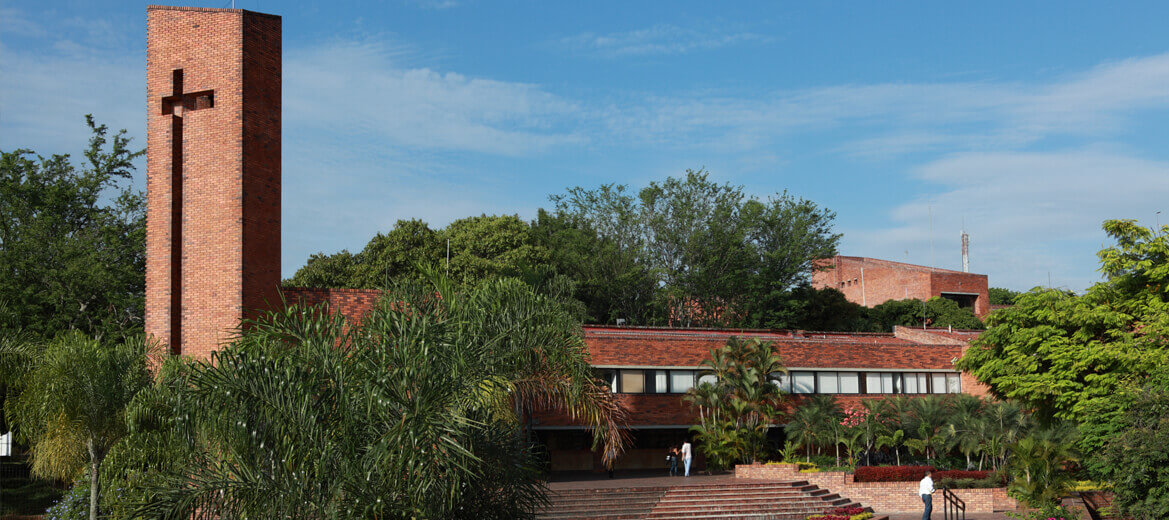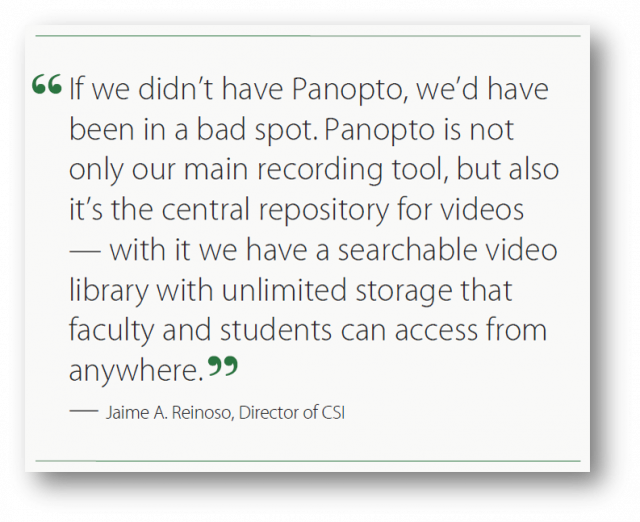- Academic Technology
Building Resilience With Learning Technologies

Pontificia Universidad Javeriana, Cali had planned to transform their digital video technologies over three years — with Panopto they did it in three days.
At Colombia’s Pontificia Universidad Javeriana, Cali, video had been part of the student learning experience for more than a decade. From lecture capture to blended learning, many students at the university enjoyed the benefits of video learning — when their professors took advantage of available technologies.
Going into the 2018-2019 academic year, the visionary leaders in the university’s Center for Informatic Services (Centro de Servicios Informáticos, or CSI) saw an opportunity for a digital transformation that would better support student outcomes by expanding the adoption of video by educators across campus, and thus provide students with the video learning resources they had come to expect.
Jaime A. Reinoso, Director of CSI at Pontificia Universidad Javeriana, Cali, identified the need for new technology that could integrate with their existing learning systems to make video a core part of learning on campus. Over the next three years, Reinoso and his team planned on working to identify the right video solution, upgrade their learning technology ecosystem, and then acclimate faculty to using the new tools and technologies.
The CSI team had already begun investigating and testing video management systems prior to March of 2020 when Colombia documented its first case of the novel coronavirus. A month later, the country was under a nationwide quarantine to fight the spread of the pandemic. As students packed up and returned home, universities across the country scrambled to find solutions that would enable the academic year to continue online. Pontificia Universidad Javeriana, Cali fortunately had a head start. If Reinoso and his team could accelerate the execution of their three-year video technology plan, they could also keep their students learning online through the pandemic.
The challenge:
Selecting and quickly deploying a video management system to move classes online
 The CSI team at Pontificia Universidad Javeriana, Cali had initially planned to shift their video recording infrastructure from the classroom to the cloud, which would simplify video content creation for faculty and, ideally, increase the adoption of video as a learning tool. Facing a pandemic and the entire campus moving to remote operations, the team knew that they also needed a scalable solution for managing and securely sharing their library of course videos, which was about to grow rapidly.
The CSI team at Pontificia Universidad Javeriana, Cali had initially planned to shift their video recording infrastructure from the classroom to the cloud, which would simplify video content creation for faculty and, ideally, increase the adoption of video as a learning tool. Facing a pandemic and the entire campus moving to remote operations, the team knew that they also needed a scalable solution for managing and securely sharing their library of course videos, which was about to grow rapidly.
By the time the pandemic reached Colombia, Reinoso and his team had already compared and tested several video management systems, which helped them narrow their decision down to two possible solutions: Panopto and Mediasite.
As the university completed testing both platforms, it became clear that Panopto was the best solution. Mediasite didn’t have the flexibility that would allow professors to record video presentations using anything other than PowerPoint slides, and editing videos required importing another tool that was unnecessarily complex. Panopto, on the other hand, was a versatile and simple all-in-one video platform. “With Panopto, you don’t have to download any software,” said Reinoso. “You only need your browser to record presentations, include quizzes, and edit your videos.”
“Panopto integrates very well with the other learning technologies we use,” Reinoso continued. By integrating Panopto with Zoom and their learning management system (LMS), Blackboard, the team could create a technology ecosystem that would both automate and expedite the process of uploading videos and making them accessible to students.
The decision was made, and the team began working immediately to prepare the campus for an expeditious transition to distance learning.
In just three days, Pontificia Universidad Javeriana, Cali implemented Panopto and integrated it with its other learning technologies. Leónardo Belalcazar, PMO Manager for the CSI team, led the training efforts over the next two weeks, conducting onsite and virtual training with faculty and associates multiple times per day. “Our professors were immediately accepting of Panopto because it was not complicated. And, because it integrates so seamlessly with Blackboard, they felt like it was part of the LMS they already knew how to use,” said Belalcazar.
The results:
Saving the semester with proactive planning and Panopto
Pontificia Universidad Javeriana, Cali hadn’t planned for a crisis that would necessitate a rapid switch to distance learning for a semester — no one had. But thanks to proactive planning and their effective implementation of Panopto, the CSI team has earned a great reputation. “Professors continue to reach out to my team for additional support because they know we are here for them. And we are in touch with faculty daily to offer guidance and support,” Reinoso said. “We no longer only interact with professors when they contact us frustrated with an IT problem,” he added. “Our relationship with professors is now very, very good!”
Within the first month of using Panopto, nearly half of all the courses offered that semester were recorded and made available to students through Blackboard. Students streamed over 12,000 hours of video during the same time. And more than a quarter of the university’s full-time professors continued to actively use Panopto for distance learning throughout the semester. With new lectures and lessons being added to Panopto every day, Reinoso knew they had made the right choice.

“If we didn’t have Panopto, we’d have been in a bad spot,” said Reinoso. “Panopto is not only our main recording tool, but also it’s the central repository for videos — with it we have a searchable video library with unlimited storage that faculty and students can access from anywhere.”
Reinoso believes that, without Panopto, many professors would have gone to YouTube to share their videos. “YouTube is full of distracting advertisements and potentially false information that the platform’s algorithm can surface through its related content suggestions. And the professors’ intellectual property isn’t protected on YouTube,” he explained. “Using YouTube to enable distance learning would have been a big mistake.”
Students at Pontificia Universidad Javeriana, Cali are equally as grateful for Panopto. Reinoso said, “The students expect these kinds of tools today. They want access to recorded lectures — they want this kind of technology available to them.”
What’s more, Panopto was critical for supporting students who didn’t have the same kind of connectivity at home that they did on campus. “Colombia is a developing country. Many students don’t have the ability to attend live video conferences from home,” Reinoso explained.
”We use Panopto to record and upload live Zoom sessions to Blackboard, so students with limited bandwidth can download the recordings and not miss a lesson. It may take some time to download, but they can still watch it, and that’s what’s important,” he said.
Looking ahead:
A revolution in education
Pontificia Universidad Javeriana, Cali is already planning for next semester. With so many unknowns, the CSI team is preparing to support learning whether it’s online, in the classroom, or a combination of both. And surprisingly, this upheaval to the traditional education model has revealed new, interesting ways the university can utilize its video technologies.
Reinoso believes this accelerated global transition to online learning will provide students with enriched learning opportunities in the future that were not previously available. “Just like the Industrial Revolution, we are experiencing a time of dramatic and rapid change that will transform education forever,” Reinoso said.
Once again ahead of the game, this revolution has already begun at Pontificia Universidad Javeriana, Cali.
With a strategic campus-wide initiative aimed at improving student outcomes already in place, Reinoso and his team see potential to enhance their ongoing artificial intelligence (AI) project, which uses predictive analytics to generate new data points that can alert educators to potential challenges, such as student dropout probability. Reinoso said, “We plan to add Panopto as one of the data sources to identify students who need extra support earlier in the semester, giving our educators actionable information for helping their students succeed.”
Beginning next semester, students will also be able to access and review recorded lectures in Panopto for the same courses from previous semesters. This offers students the ability to learn from other professors teaching the same course, giving them new opportunities for deeper learning. Reinoso explained, “We are all about the students. Allowing students to access a broader set of learning materials can help them master new concepts or simply connect with a different style of teaching that is more suitable to how they learn.”
And finally, the team has also created a new line of revenue for the university with Panopto. Pontificia Universidad Javeriana, Cali will soon offer alumni paid, secure access to course content in its video library.
Universities worldwide may experience challenges ahead that threaten their livelihoods, but Reinoso and his team welcome the disruption. “With Panopto, we have new opportunities to diversify our revenue streams and develop innovative products for yet-untapped markets!”
About Pontificia Universidad Javeriana:
The Pontificia Universidad Javeriana is a Catholic institution of higher education, with campuses in Bogotá and Cali, Colombia. As a university with a distinct regional, global, and interdisciplinary perspective, it’s committed to achieving excellence through teaching, research, and service.
One of the oldest, most traditional and prestigious Colombian universities, Pontificia Universidad Javeriana is ranked 18th by U.S. News & World Report among top global universities in Latin America.




